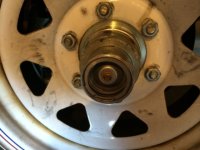RobMcClain
Member
- Joined
- May 21, 2012
- Messages
- 357
- Reaction score
- 0
- C Dory Year
- 2006
- C Dory Model
- 23 Venture
- Vessel Name
- Freedom
At the risk of sounding like a real moron, how do you guys effectively store a loaded grease gun? I have a cartridge type of gun that I keep grease in for my trailer's wheel bearings. When not in use I try to keep the plunger locked back so there is no pressure on the grease, but it often slips out of the notch and puts pressure on the grease. Then of course the grease slowly seeps around the plunger so I generally lose the ability to use it and if I pull the plunger back it pushes all that grease out the plunger hole.
When I put a new cartridge into the gun I usually only use a bit of grease when checking the bearing buddies but I haven't found any good way to remove the open cartridge so I leave it in and hope to keep the plunger locked back so I don't waste the new grease - but often the plunger slips and engages and by the time I see this has occurred much of the grease has already oozed behind the plunger. This especially occurs when we are on the road towing and I want to have the gun handy. I've had a few guns over time and this still occurs. So what am I doing wrong???
Rob :?
When I put a new cartridge into the gun I usually only use a bit of grease when checking the bearing buddies but I haven't found any good way to remove the open cartridge so I leave it in and hope to keep the plunger locked back so I don't waste the new grease - but often the plunger slips and engages and by the time I see this has occurred much of the grease has already oozed behind the plunger. This especially occurs when we are on the road towing and I want to have the gun handy. I've had a few guns over time and this still occurs. So what am I doing wrong???
Rob :?

